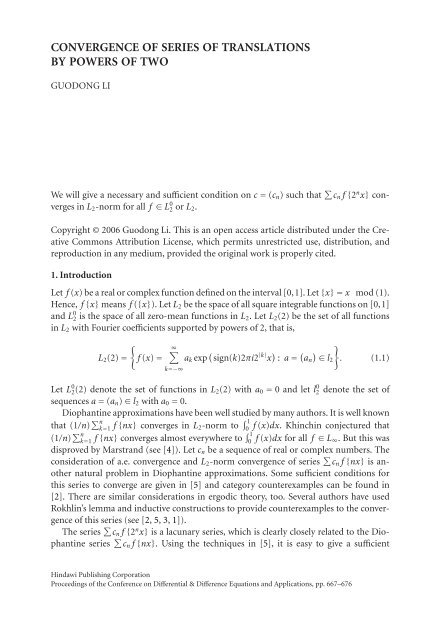DIFFERENtIAl & DIFFERENCE EqUAtIONS ANd APPlICAtIONS
DIFFERENtIAl & DIFFERENCE EqUAtIONS ANd APPlICAtIONS
DIFFERENtIAl & DIFFERENCE EqUAtIONS ANd APPlICAtIONS
You also want an ePaper? Increase the reach of your titles
YUMPU automatically turns print PDFs into web optimized ePapers that Google loves.
CONVERGENCE OF SERIES OF TRANSLATIONS<br />
BY POWERS OF TWO<br />
GUODONG LI<br />
We will give a necessary and sufficient condition on c = (c n )suchthat ∑ c n f {2 n x} converges<br />
in L 2 -norm for all f ∈ L 0 2 or L 2 .<br />
Copyright © 2006 Guodong Li. This is an open access article distributed under the Creative<br />
Commons Attribution License, which permits unrestricted use, distribution, and<br />
reproduction in any medium, provided the original work is properly cited.<br />
1. Introduction<br />
Let f (x) be a real or complex function defined on the interval [0,1]. Let {x}=x mod (1).<br />
Hence, f {x} means f ({x}). Let L 2 be the space of all square integrable functions on [0,1]<br />
and L 0 2 is the space of all zero-mean functions in L 2 .LetL 2 (2) be the set of all functions<br />
in L 2 with Fourier coefficients supported by powers of 2, that is,<br />
L 2 (2) =<br />
{<br />
f (x) =<br />
∞∑<br />
k=−∞<br />
a k exp ( sign(k)2πi2 |k| x ) : a = ( a n<br />
)<br />
∈ l2<br />
}. (1.1)<br />
Let L 0 2(2) denote the set of functions in L 2 (2) with a 0 = 0andletl2 0 denote the set of<br />
sequences a = (a n ) ∈ l 2 with a 0 = 0.<br />
Diophantine approximations have been well studied by many authors. It is well known<br />
that (1/n) ∑ n<br />
k=1 f {nx} converges in L 2 -norm to ∫ 1<br />
0 f (x)dx. Khinchin conjectured that<br />
(1/n) ∑ n<br />
k=1 f {nx} converges almost everywhere to ∫ 1<br />
0 f (x)dx for all f ∈ L ∞ . But this was<br />
disproved by Marstrand (see [4]). Let c n be a sequence of real or complex numbers. The<br />
consideration of a.e. convergence and L 2 -norm convergence of series ∑ c n f {nx} is another<br />
natural problem in Diophantine approximations. Some sufficient conditions for<br />
this series to converge are given in [5] and category counterexamples can be found in<br />
[2]. There are similar considerations in ergodic theory, too. Several authors have used<br />
Rokhlin’s lemma and inductive constructions to provide counterexamples to the convergence<br />
of this series (see [2, 5, 3, 1]).<br />
The series ∑ c n f {2 n x} is a lacunary series, which is clearly closely related to the Diophantine<br />
series ∑ c n f {nx}. Using the techniques in [5], it is easy to give a sufficient<br />
Hindawi Publishing Corporation<br />
Proceedings of the Conference on Differential & Difference Equations and Applications, pp. 667–676

















